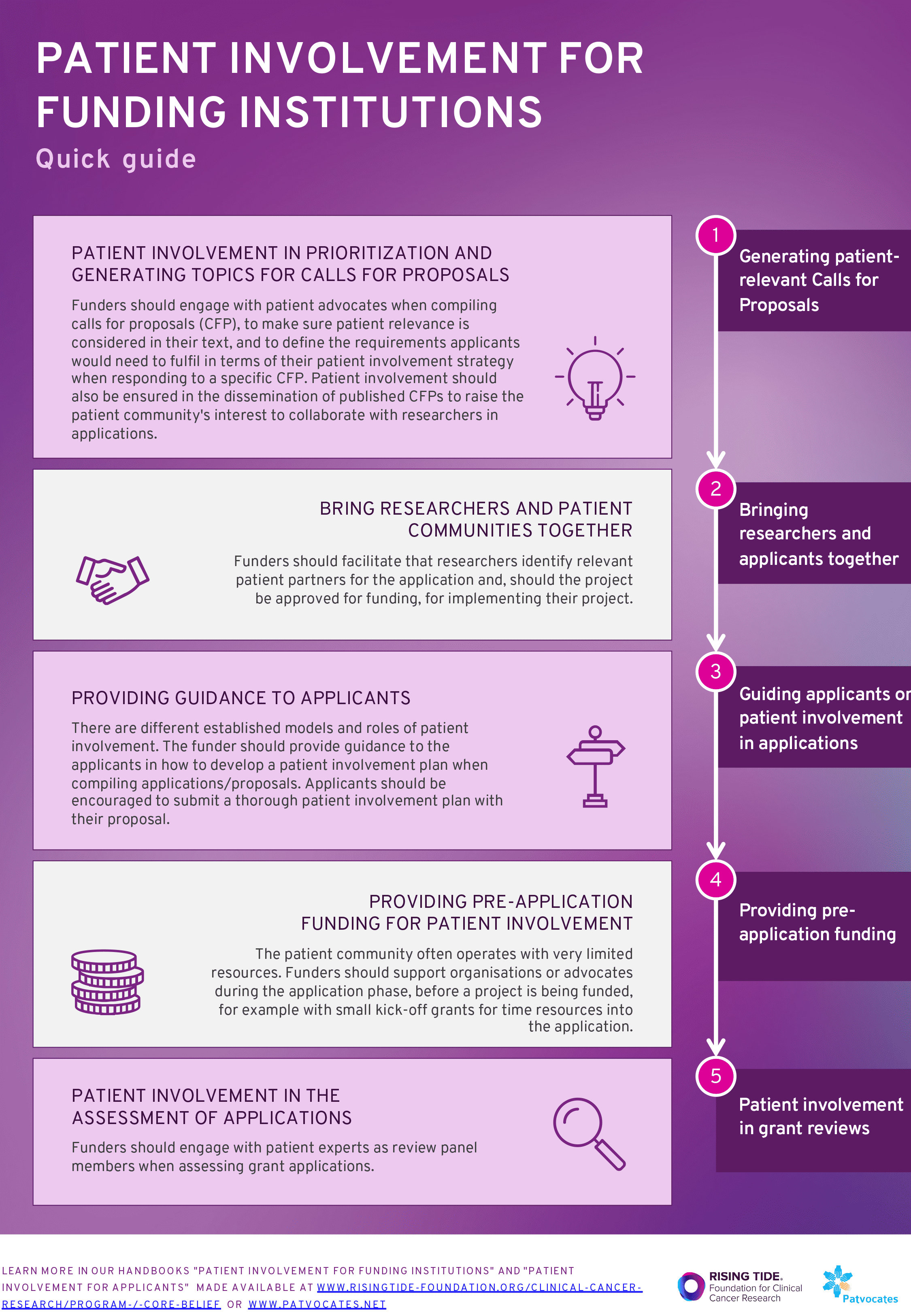Patient Partner Involvement in Research
Throughout the website, we use the Patient-Centered Outcomes Research Institute (PCORI)’s definition of patient partners, which includes patients (those with lived experience), family members, caregivers, and the organizations that are representative of the population of interest in a particular study.
The significance of patient partner involvement in research is widely recognized. It enhances the effectiveness of clinical and medical research, ensuring outcomes meet patients’ needs. By collaboratively identifying and understanding unmet needs, and incorporating patient input throughout clinical trials, we improve the development and evaluation of new treatments.
Learn more about the process of implementing patient partner involvement in research: Research Involvement and Engagement.

Guidance to the application requirements are divided in:
Step 1: Pre-Application Grant
Grants up to USD 4,000 that aim to bridge the funding gap for patient partners who contribute to developing a study question that can be submitted as a letter of intent to RTFCCR. This award is designed to cover travel costs for preparatory meetings and to compensate patient partners for their time.
Step 2: Choice of Patient Partner Involvement Model in Research Projects
Applicants must provide a detailed explanation justifying the selected patient partner role for the project. Please refer to our description of patient partner roles in the funding guidelines.
Step 3: Patient Partner Involvement in Research Planning Checklist
This checklist highlights key Patient Partner Involvement in Research points to consider during the application phase, project implementation, and beyond. For more information, please refer to our funding guidelines.
Step 4: Completing the Patient Partner Involvement in Research Plan Template
The plan should outline Patient Partner Involvement in Research processes during both the project application generation and implementation phases. It should describe the collaboration, clearly describe expected outputs, and explain how patient partner input will be processed and incorporated. Please download the plan template here.
Step 5: Review of Applications by Patient Partners
In addition to the Patient Partner Involvement in Research Plan, applicants must answer a set of questions to give patient partners reviewing each application a clearer understanding of the addressed patient needs and how they are being met.
Webinar series
Partnering with Patients to Improve Clinical Trials
In the first episode of our series, we highlight a collaboration between a patient partner and a clinician aimed at developing patient-centric endpoints for a geriatric prostate cancer clinical trial.
The second episode of our webinar series demonstrates how researchers and patient partners can co-design clinical trials that truly resonate with patients and address their most pressing concerns. Based on insights from the lung cancer community.
The third episode of our webinar series illustrates the transformative impact of patient partner involvement in the research process. By examining the POSITIVE study, a breast cancer-focused clinical trial, we explore real-world examples of successful patient partner-researcher collaborations.
Patient Partner Involvement in Underserved Areas
This grants program, initially focused on Uganda and Kenya, has served as a pioneering initiative to advance clinical cancer research for rapid impact on patient outcomes in sub-Saharan Africa. It has also enhanced the capacities of applicants from these countries, empowering them to effectively compete as leading investigators for global research opportunities in the future. We are sharing the lessons learned in patient engagement from this pilot so they can serve as exemplary models for other African countries.
Read more about this initiative: Advancing Cancer Research in Sub-Saharan Africa.
Patient Involvement Materials
DIA considerations guide to implementing patient-centric initiatives in health care product development
Recommendations on patient involvement for funding institutions
Recommendations on patient involvement for applicants of collaborative research grants
Recommendation for patient organizations and patient advocates on their involvement in collaborative research projects
Empfehlungen Patientenorganisationen und Patientenvertreter zur Beteiligung an kollaborativen Forschungsprojekten
Adopting recommendations for implementing patient involvement in cancer research a funder’s approach
The Rising Tide Foundation and Patvocates have jointly developed guidance documents to support public and private health research funding institutions, research teams, and patient organizations with recommendations on organizational models, potential patient community contributions, checklists, and templates that support patient involvement in the generation of calls for proposals, the preparation and review of grant applications, and the implementation of research projects.
These recommendations are based on patient engagement models and methodologies established by leading collaborative initiatives, such as EUPATI, PFMD, PARADIGM and INVOLVE; interviews of patient engagement experts in patient organizations, funding institutions, regulatory authorities and academic institutions in the USA and Europe; as well as practical experience of patient advocates in the Patvocates team.
Funding Opportunities
Open Call
We accept letter of intent (LOIs) all year round and do not have specific deadlines. Once you have submitted your LOI, you will receive further information regarding timing and next steps.
Pre-application Grants
Pre-application grants provide gap funding to support patient experts’ helping to develop grant applications/ protocols.


